by Jack
I’ve always enjoyed history and military history in particular. This article is a niche in that later history, its a brief history of the bayonet. Read, learn something unique and above all… enjoy:
Nobody has been able to offer proof positive where the term bayonet originated, but it’s a fair bet it came from a city known for its cutlery, Bayonne , located in the Pyrenees between France and Spain, probably in the early 1600’s.
The first bayonet was likely a hunting dagger and had nothing to do with a stabbing instrument on the font of a long gun. But, as the use of military firearms came into great use and the pike weapon, (long poles with a stabbing blade) began to fade into obsolescence, a compromise resulted in a 1 foot long, two sided, pointed blade fitted to a 1 foot long handle that could be shoved down the muzzle of a musket and voila’, now we’re back to the pike, er, sort of.
This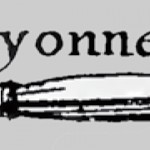 innovation eventually became known as the “plug” bayonet because it worked like plug into the barrel. Of course this ended the use of the musket and its viability as a defensive weapon was marginal at best. But, it did the solve the problem of what do you do after you fired your first shot is fired and the enemy is charging you from 60 feet, screaming with swords flailing in the air. It took a good minute to reload this old muskets.
innovation eventually became known as the “plug” bayonet because it worked like plug into the barrel. Of course this ended the use of the musket and its viability as a defensive weapon was marginal at best. But, it did the solve the problem of what do you do after you fired your first shot is fired and the enemy is charging you from 60 feet, screaming with swords flailing in the air. It took a good minute to reload this old muskets.
This crude “plug” bayonet endured for about 100 years, before anyone could think of something better, but the slow loading muskets of the day also meant they didn’t need much better.
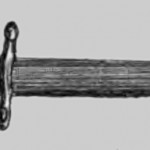 Enter the better bayonet: British General Hugh Mac Kay (c.1640-1692) described the use of the new “ring” bayonet while writing of his experiences in the Scottish War of 1689, “Muskets have also been observed with a tube brazed to the barrel, to accept the plug bayonet. Neither approach was very satisfactory. The ring bayonet fit loosely and was prone to dismount.” ( It must have been a distressing feeling to be in a bayonet charge and the bayonet falls off the end of musket barrel.)
Enter the better bayonet: British General Hugh Mac Kay (c.1640-1692) described the use of the new “ring” bayonet while writing of his experiences in the Scottish War of 1689, “Muskets have also been observed with a tube brazed to the barrel, to accept the plug bayonet. Neither approach was very satisfactory. The ring bayonet fit loosely and was prone to dismount.” ( It must have been a distressing feeling to be in a bayonet charge and the bayonet falls off the end of musket barrel.)
We find necessity once again is the mother of invention. This came about during the Siege of Charleroi, in 1693. French inventor, Vauban, placed the bayonet into a socket that encircles the muzzle of the gun, leaving it free for shooting with the bayonet still inserted on the musket! .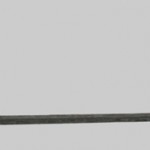
In the ensuing years, the bayonet saw a lot of changes in blade configuration, including the sword bayonet, which was neither a good sword or a good bayonet.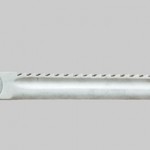 See picture on right – Turkish curved blade) The real advancement came after the American Civil War and finally someone developed a decent lock mechanism using a button release, held in place by a flat spring. Why it took 200 years to figure this one out is surprising, considering it’s such a critical piece of equipment. At this time the Minié rifle spelled the end of Napoleonic tactics, by making it suicidal for infantry to line up on an open battlefield, to bad a lot of Generals in WWI never got this memo. The eventually result was trench warfare and barb wire. This change was met by the adoption of the sawback bayonet for cutting wire (and people). (See picture on left). This bayonet was considered a weapon to inflict torture, so if you were captured by the enemy carrying one…it was a death sentence.
See picture on right – Turkish curved blade) The real advancement came after the American Civil War and finally someone developed a decent lock mechanism using a button release, held in place by a flat spring. Why it took 200 years to figure this one out is surprising, considering it’s such a critical piece of equipment. At this time the Minié rifle spelled the end of Napoleonic tactics, by making it suicidal for infantry to line up on an open battlefield, to bad a lot of Generals in WWI never got this memo. The eventually result was trench warfare and barb wire. This change was met by the adoption of the sawback bayonet for cutting wire (and people). (See picture on left). This bayonet was considered a weapon to inflict torture, so if you were captured by the enemy carrying one…it was a death sentence.
In 1882, the German firm, Gebrüder Weyersberg (Weyersberg Brothers), patented the coil spring press stud. See picture on the right. 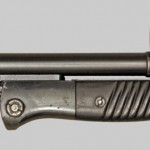
In 1884, Germany introduced the M1871/84 knife bayonet, the first knife-length bayonet to become general issue in a major army. Up to this point, sword bayonets had blades ranging from 15-25 inches. At 10 inches in length, the M1871/84 bayonet’s blade represented a radical departure from 100 years of bayonet design.
Lastly, here’s a few pictures of modern bayonets with multifunction blades and handles used for cutting electrical wire to barb wire. The first shown is a stainless steel Russian AK47 bayonette made in the 1950’s. The next is an American version followed by a universal type bayonet with a composite handle.
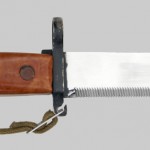
With many thanks for pictures and historical data from the World of Bayonets.

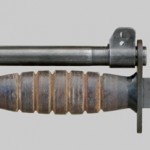
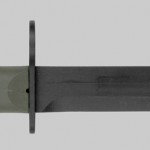
This was a fun post.
If I may add a couple of points I have always found interesting, especially considering the purpose and use of a bayonet in war times.
Most USA bayonets were issued with a unsharpened edge, one of the explanations the military gave was that a sharpened bayonet would cause injuries to the troops. And troops were instructed not to sharpen them.
There was also rumors that a sharpen edge bayonet when used to plunge through the enemy might cut through a bone get stuck on that bone (Rib mostly as stories went), and not be easily removed.
And the story goes on to relate Military Brass seemed to feel a dull edge would penetrate and break bones and be easier to pull out, verse the sticking in and to the bone.
Hollywood movies and such were prone to depicting troops sitting around and sharpening them, not true, but that’s Hollywood.
The “Sawback’ bayonet pictured had teeth like a rip saw on the back edge and was issued to German engineering and machine gun troops, to help in sawing logs and such in building a nest from which to protect them from return fire. However some regular troops got their hands on them, and used them in a vicious manner they were not originally intended for and creating more viscous tearing wounds in a ripping flesh manner.
That lead to the opposing troops as Jack noted to show no mercy and often shot the bearer of that style bayonet on sight and capture.
In the beginning with open field battlefield and standing charges, well longer was better, as more guerrilla style war fair tactics become the norm length was reduced (many WWI bayonets were recalled and shortened)by almost half as noted to make the rifle more maneuverable.
Today if you have a older family members “GI bring back” bayonet from the theater they fought in,(from either side) check it out and reflect on the possibility of action it saw, and the part it played in freedoms many challenges.
What I didn’t expect to find in this history was the lack of innovation. The plug bayonet was the best they could come up with for a 100 years?
Interesting “points’ you made Harold, especially about the sharpening, now that was news to me, but now that you have explained it, it does make sense.
My wife inherited this helmet and bayonet among a bunch of other junk from her grandmother who said it belonged to her father who was in the german army I think in world war one? any who it has the saw blade and it is about two feet long. what would something like this be worth anyway? any ideas? seems like it is in average shape no rust and a few dings like it was carried.
Love this stuff. From the link you provided–
http://worldbayonets.com/Bayonet_Identification_Guide/Britian__Pre_WWII_/B1072_2/B1072-3.html
In the above photo, the crown represents the British Crown.
G R— G represents King George V. R is for Rex which is latin for Rules, hence George Rules.
1907 is the model.
12 of ’18 is when it was made.
Sanderson (of Scheffield, England) is the maker.
This bayonet will fit the British No.I Mk III and P14 Enfield rifles, and the U.S. Model 1917.
For all the rest of you history geeks, more info here—
http://www.usmilitaryknives.com/Table%20of%20Contents.htm
I’m no expert, but I think a German sawback in decent shape is worth somewhere between $250-$500 on average. They are on ebay right now.